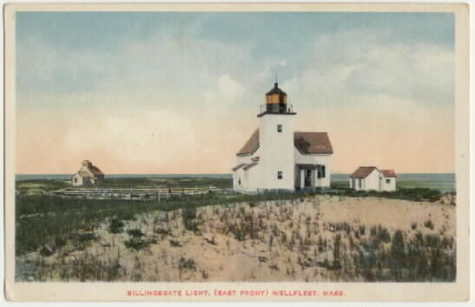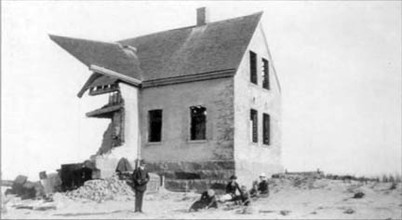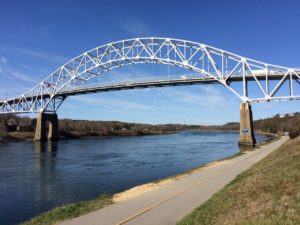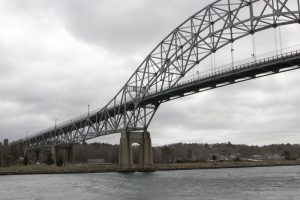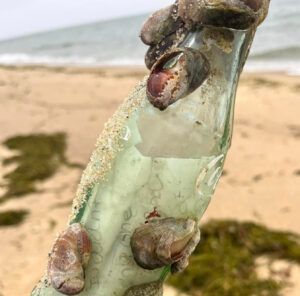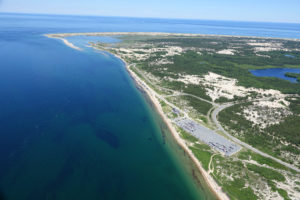The peninsula of Cape Cod is connected to several beautiful and historic islands nearby. Nantucket sits thirty miles off shore and is a step back in time with nary a traffic signal to be found. Martha’s Vineyard, visible from the southwestern Cape shore contains six unique towns and is home to the Wampanoag Tribe in Aquinnah. The seven Elizabeth Islands and several islets stretch sixteen miles out into Buzzards Bay. Though most are uninhabited the largest of the islands, Naushon is historic for the fact that during the War of 1812 the British would often use Tarpaulin Cove as a starting point for raids on nearby areas. Monomoy Island contains a spectacular wildlife refuge and is known for large seal populations as well.
Those islands exist and thrive today. However did you know that even as recently as one hundred years ago there was another island located inside Cape Cod Bay? For many decades it was a bustling community; today it is merely a footnote in the story of Cape Cod. It was Billingsgate Island, the ‘lost island.’
Once upon a time there was an island located two and a half miles west of the Wellfleet shore, just south of Jeremy Point. It was known as Billingsgate Island. The ‘Billingsgate’ name once represented all of Wellfleet and Eastham until Wellfleet separated itself and adopted its present name in 1763. It was likely named for the famed Billingsgate Fish Market established in London in 1699. In its heyday the island encompassed roughly sixty acres of land. It was a prosperous fishing village which would be inhabited during the warmer months by as many as eighty people.
The peak of Billingsgate was the mid-19th century. The populating of the island would begin to grow in 1822 when a lighthouse would be built. The keeper of which would remain on the island year-round, sometimes alone for months at a time in winter. In the decades following the construction of the lighthouse the island would come to also include thirty homes, a schoolhouse, a store, oil works, and a baseball team which would row across the bay to play other teams from the Outer Cape. It was a paradise out of a storybook.
However, not too long after the lighthouse was built it became apparent that something was happening to the island. The same erosion which embattles the coastline today was slowly chipping away at Billingsgate. The lighthouse would be moved away from the eroding shore around 1868, complete with a protective breakwater, buying some time for the structure.
With one eye on the booming fishing and whaling industries and the other on the creeping erosion the community would continue to thrive into the latter half of the 19th century. Then slowly but surely the fishermen and their families would start to leave Billingsgate. The homes would be taken down and floated across the bay to be resurrected in the towns along the Outer Cape. The twenty-by-twenty-foot schoolhouse would be taken down around the turn of the 20th century when only about six families remained on the island.
The 1900’s saw the demise of Billingsgate Island. The homes which had dotted the land had been moved, only oyster shacks and hunting camps remained. The lighthouse would crumble in a storm on the day after Christmas in 1915 and be replaced by a skeleton light fixture on a tripod. The island would remain a haven for shellfishing, but these were mainly regulated to daytrips from the mainland. The last keeper of the light, Henry Daniels, would spend three nearly-uninterrupted years on the disappearing land mass at the same time guarding the valuable oyster beds from 1917-1920.
The natural process of erosion never ceases and by 1933 the skeleton light tower had been replaced by a lighted bell buoy. In 1942 the tides would submerge the island for the first time, officially ending Billingsgate Island and creating Billingsgate Shoal. Today the area known as ‘Cape Cod’s Atlantis’ still lives on. It lives on in photographs, the homes which are dotted around Wellfleet and surrounding areas, artifacts, and writings about the island including from Henry David Thoreau in his Cape Cod book. The shoal is frequently visible at low tide making it a popular picnicking spot. If one is lucky they may even stumble upon a brick from the old lighthouse’s foundation.
It is impossible to step foot on the sandy shoal of what was once a thriving community and not take a moment to think about the power of the sea. It is impossible not to think of all that once stood there and remember to enjoy each and every day because at some point it will all be but a memory, much like Billingsgate Island.
By Christopher Setterlund




